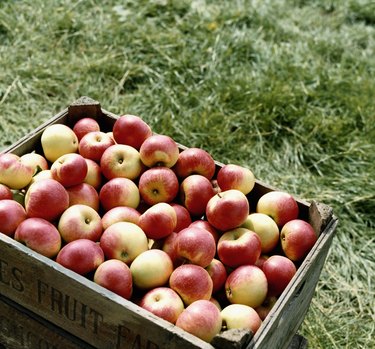
Apples are a quick, sweet and crunchy snack that can simultaneously satisfy your craving and deliver nutrients the body needs to function. Because they contain carbohydrates in the form of sugar, apples will, indeed, raise your blood sugar -- though only slightly. A medium apple is a low-glycemic-index food, meaning it releases sugar slowly into your bloodstream. If you are counting carbs due to concerns about blood sugar levels, eat your apple with the skin on. The fiber in the skin reduces the amount of net carbs in the apple.
All Carbs Aren't Created Equal
Video of the Day
Starches and sugars are carbohydrates that raise your blood sugar, while fiber is a carb that doesn't. The skin on apples is made of insoluble fiber, which helps digestion. The amount of fiber is counted in the total carbs, but because fiber doesn't raise your blood sugar, the amount of fiber gets subtracted from the total carbs. One large apple contains 28 grams of carbs and 5.8 grams of fiber. Pairing carbs with high-protein foods -- like an apple with low-fat cheese -- is another way to keep them from raising your blood sugar too quickly.
Video of the Day
- Joslin Diabetes Center: How Does Fiber Affect Blood Glucose Levels?
- U.S. Department of Agriculture: Nutrient Database: Apples
- American Diabetes Association: Carbohydrate Counting
- NYU Langone Medical Center: Bulking Up On Fiber
- Harvard Health Publications: Glycemic Index and Glycemic Load for 100+ Foods